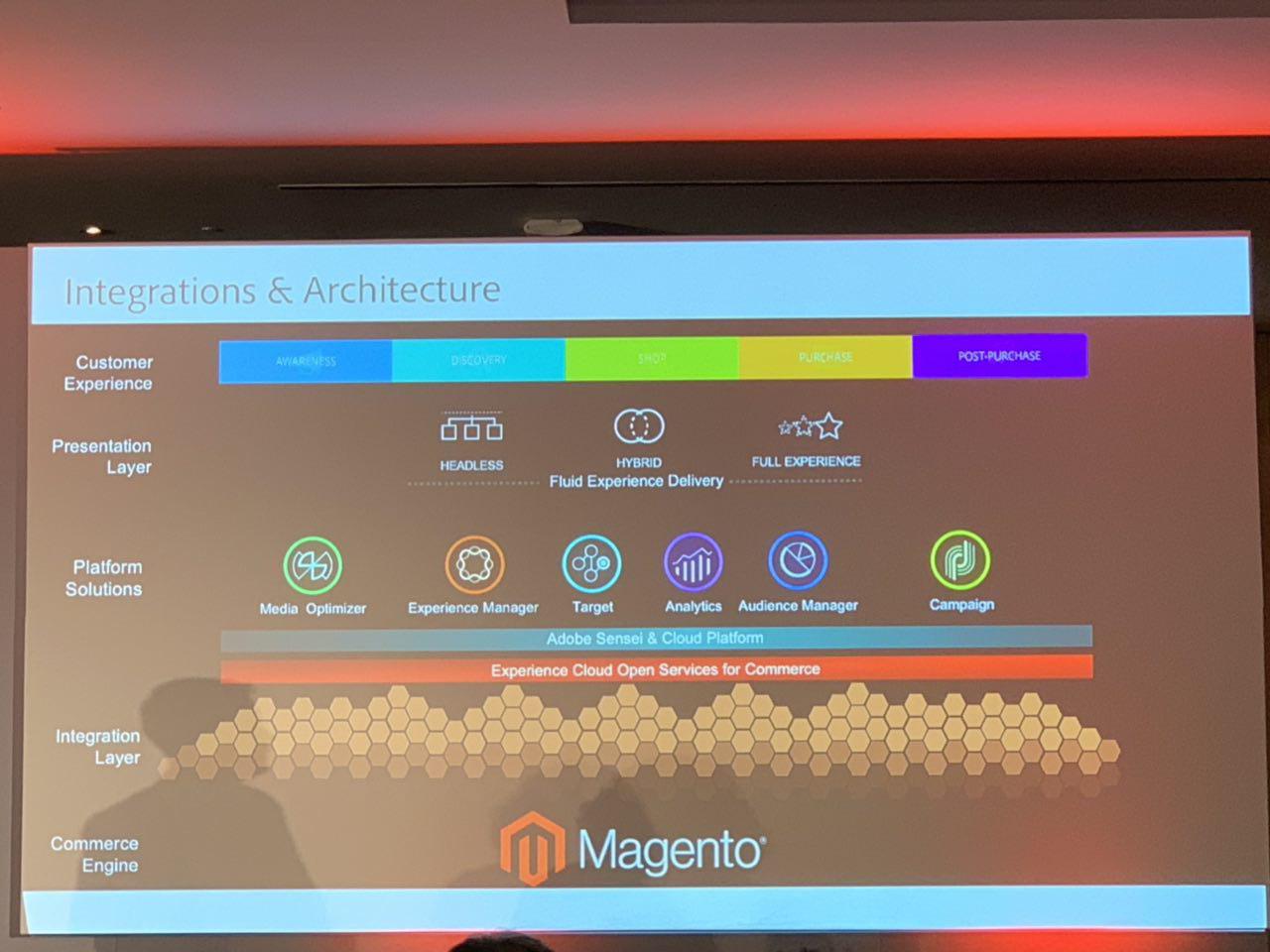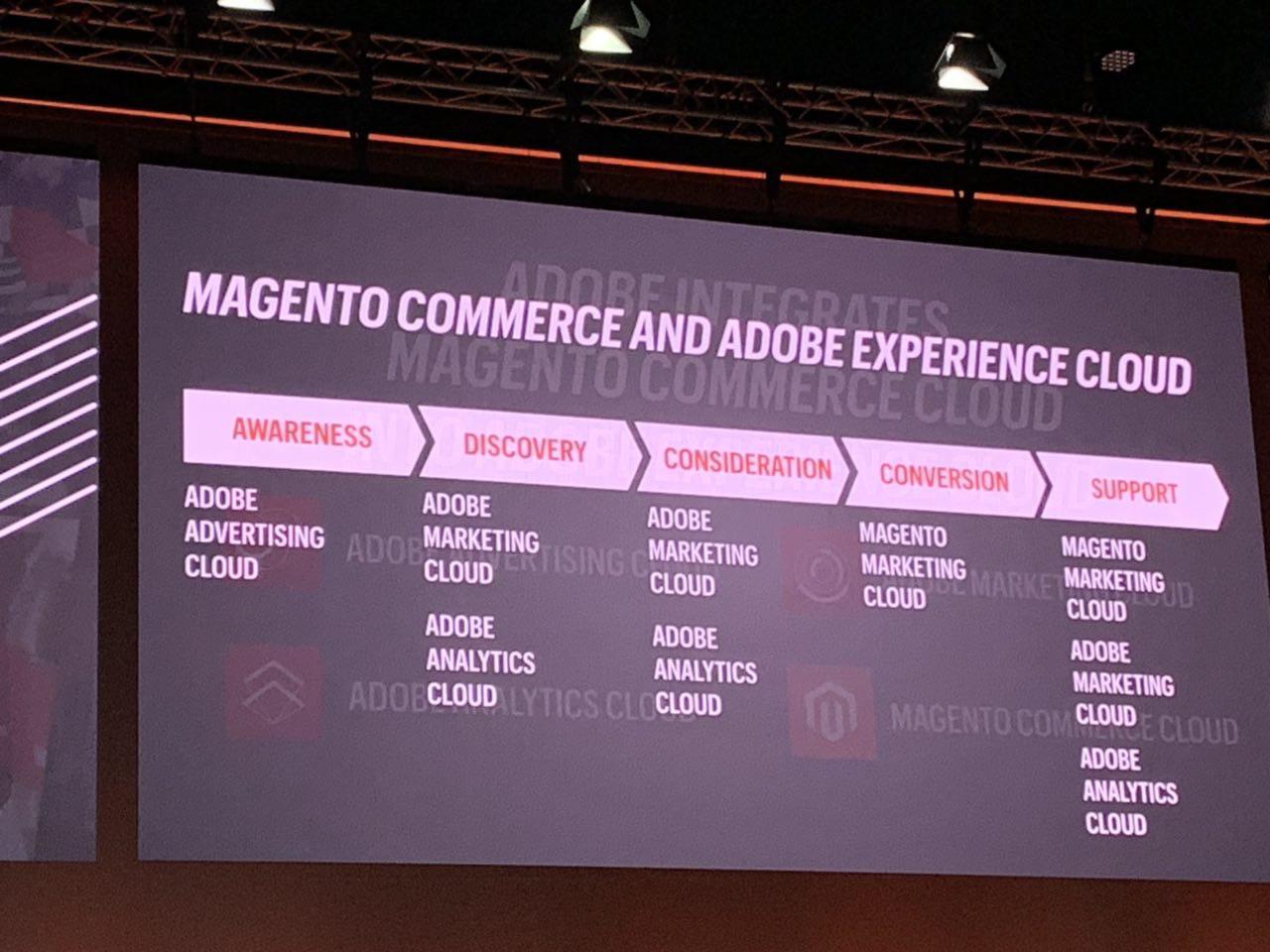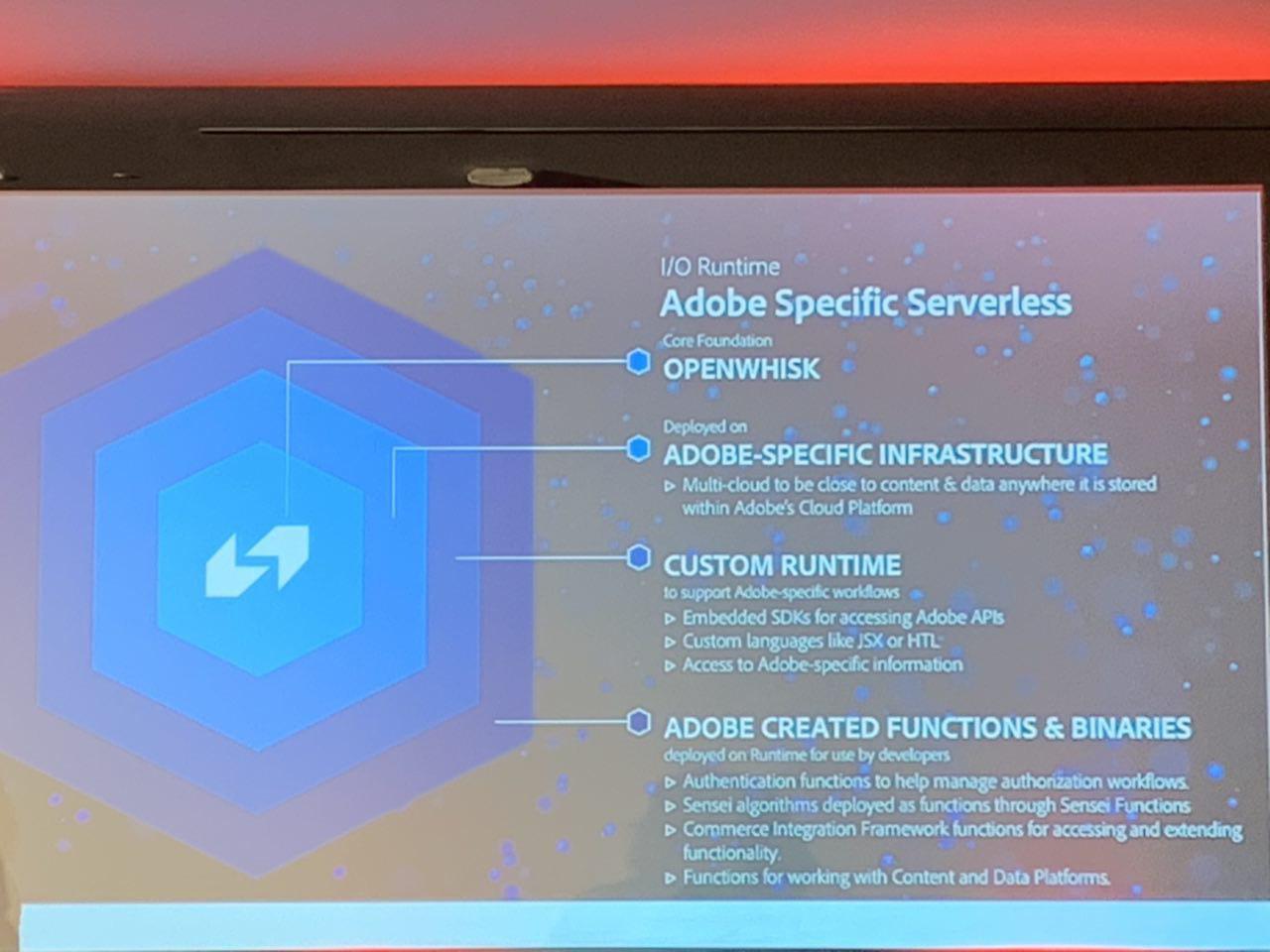Magento as Part of Adobe Experience Cloud

It’s not a secret that Magento successfully operates as a part of Adobe Experience Cloud. “Few people laughed, few people cried, most people were silent” when the acquisition has been announced for the first time. Of course, there were lots of dissatisfied fellows who predicted the worst case scenario for our favorite e-commerce platform. At the same time, many enthusiasts were happy to see the new source of investments, and they were right: Magento is here, nobody tries to kill the community edition, new features are implemented as planned and even faster. Since a certain amount of time has already passed, we’d like to share the opinion of the Firebear team on Magento as a part of Adobe Experience Cloud.

Table of contents
Adobe Commerce Cloud

A new Magento 2 edition has been released recently. Meet the Adobe Commerce Cloud – the latest Magento 2-based product that offers the features of the Commerce platform from the cloud. As an e-commerce merchant, you get a more flexible solution oriented at both B2B and B2C businesses. For further information, follow this link: Adobe Commerce Cloud: Overview & Features.
Magento 2 Adobe Experience Cloud Opportunities Overview
Below, we’d like to draw your attention to the key benefits of the Magento Adobe acquisition. Our favorite platform was one of the most powerful e-commerce tools on the market, and now it is even more potent. So how did the Adobe Experience Cloud change Magento’s orientation towards buyers, merchants, marketers, and developers?
Integration With Existing Adobe Tools
Magento has been a source of top-notch digital commerce for years. It also offered strong order management capabilities, some analytical tools, multiple ways for integration, and engaging customer experience. With the appearance of Magento 2, all these opportunities have been completely revamped and enhanced dramatically.
The Adobe acquisition pushed the technology forward even more. And if you cannot leverage certain Adobe products right now (within the Magento admin), we believe that the ability to combine all the ecosystem’s products will be offered in the nearest future. The most user-friendly and intuitive shopping experience, efficient and seamless order management and predictive intelligence tend to be combined and unified within the one experience platform.

B2С and B2B Experience Within Post-Acquisition Era
Magento 2 has always been a number one e-commerce platform with the ability to provide B2B features. Of course, most of them were not available by default, but you could easily get them via third-party extensions. Just check this post to gain an understanding of what B2B features are still provided as standalone modules: Magento 2 B2B Extensions and Solutions.
Later, new and new B2B features appeared as a part of the Commerce platform and then some of them have been represented within the Open Source version. The trend is clear and visible: the post-acquisition era leads us towards the complete merge of both B2B and B2C experiences. As a Magento 2 merchant, you will no longer need to scratch head over the most efficient way of enabling certain B2B features on the basis of the platform that initially was a B2C solution. So, the integration opens a way better opportunities related to the B2B experience, and you can always improve them with the best third-party extensions.
Top-Notch Content Creation & Analytics
What is the first association that appears in your mind when someone says Adobe? Of course, it is Photoshop. Although it is a part of Creative Cloud, the tool is one of the most popular solutions offered by the company. If you are an old salted marketer you may disagree with us since your first association may be Adobe Analytics or Experience Manager, but marketers are not the majority of people inhabiting this planet, are they?
So, if Photoshop is your first association with Adobe, what is your association with Photoshop itself? Right! Fully featured creation of great visual content. It was almost impossible in the case of the default Magento admin, but things tend to change! The Magento Adobe acquisition is going to introduce lots of new stuff designed to improve the visual aspect of your online storefront out of the box.
The same is about analytics. If previously it was impossible to get the precious data related to the way your business operates with the help of the default means only; now, there is a part of Adobe Experience Cloud that offers one of the most potent analytics tools. And you can easily integrate the two systems together. At the same time, it is possible to rely on third-party modules. The best solutions are gathered here: Magento 2 Advanced Analytics Extensions.
Open Source Ecosystem & Community
There were so many rumors that the open source nature of the Magento ecosystem would no longer exist after the Adobe acquisition, but none of them is true. The company supports community initiatives by implementing fixes submitted by community members. Furthermore, you can fully customize the offered experience making it suitable for your particular business needs. And a broad variety of extensions is the direct confirmation of the platform’s nature. Even if Adobe decides to abandon the Open Source version, there are enough enthusiasts and specialists from the variety of fields to maintain the community platform. But there are no reasons to worry: the open-source ecosystem extends far beyond the web shopping cart which is highly appreciated by Adobe. It combines merchants, partners, and developers who simultaneously get and provide the best possible experience over all levels of the ecosystem.
Enterprise Use Cases
Another important feature behind the Magento platform is the ability to solve the most complicated enterprise issues. While the platform offers tools for the smallest businesses, it allows the largest market players to leverage the solution to satisfy their business needs. You can either use the standard tools or leverage the PWA approach which is now not only officially supported but also has an essential place among planned updates.

Of course, being a part of Adobe Experience Cloud, Magento offers much broader opportunities in this area than anytime before. As a merchant (an enterprise client), you can fully leverage other tools from the suite: Analytics, Audience Manager, Content Manager, Campaign, Advertising, and Target.
Truly Connected Shopping Experience
Since the beginning, Magento enables buying everywhere. Since recent updates, it enables fulfillment anywhere. It is not the merit of the Adobe Experience Cloud (as many of the described features), but we are talking about the post-acquisition opportunities, so it is necessary to specify both features here.
As a merchant, you can freely reach your clients on any devices, anytime, anywhere. The platform offers all the necessary tools for achieving this goal. Furthermore, there are tons of Magento 2 templates and themes that substantially extend the visual aspect and frontend features of the platform. And don’t forget about Magento 2 extensions for the improved frontend experience. They make the life of your customers much easier providing a more engaging shopping process.
As for the fulfillment functionality of the platform, it becomes more potent with every new release. The introduction of the Magento 2 Multi-Source Inventory is the main evidence of the improvements in this area.

Conclusion
So, what are the benefits of being a part of the Adobe Experience Cloud? Let’s summarize them below:
- New growth opportunities represented by the ability to analyze product, customer, and sales data;
- Advanced insights sharing across your company;
- Regular updates, vital improvements and fixes, continuous investments, and overall stability;
- Top-notch scalability and the ability to satisfy the most complicated enterprise needs;
- Magento 2 integrability with other Adobe Enterprise Cloud products;
- Support for both Open source and Commerce versions of the platform.
Adobe Experience Cloud Products
Adobe Experience Cloud is an all-in-one experience solution; and below, we shed light on its core products. The platform brings together all the necessary marketing technologies in a single place so that you can do everything from running email campaigns and managing your content to automating your ads and measuring the success. The integrated approach leads to the seamless experience. From the perspective of Magento-based e-commerce, the Cloud opens much more extensive opportunities than any similar solutions, so let’s take a look at how this experience is achieved.
Analytics
As mentioned above, the Magento 2 ecosystem offers lots of reliable analytics tools. You might have already used some of them or just want to give a particular extension a try, but chances are Adobe will replace all of them. You need to know your audience, aren’t you? And this is no longer a problem since Magento 2 is a part of Adobe Experience cloud. The integration with the appropriate tool will help you find out who your customers are. Adobe Analytics is the leading tool in its area. It offers analytics and measurement features to guide you beyond data to insights you can act on. Being more than simple web analytics (but remains easy to use), it’s customer intelligence.
Audience Manager
Now, when the data is collected via the means of Adobe Analytics, you no longer need to rely on third parties to get the most out of it. Gathering information always was half the answer. That’s why Adobe offers another robust tool – audience manager. It helps to get a deep insight into the way your customers behave. Gather every scrap of the precise information on your clients (and potential clients of course) from any source into a single profile. Next, share it across all Adobe’s products. It’s a good idea to implement further campaigns using segmentation strategies. Use these Magento 2 modules to get the most out of it: Amasty Customer Segmentation and Mirasvit Customer Segmentation.
Experience Manager
Adobe Experience Manager dramatically enhances the default content management. It lets you build powerful and personal experiences for any devices. And the cloud is the key to your success in this area. The tool is designed to provide you with enterprise-level content management, privacy, and scalability. As a result, you can create rich media content that adapts to every screen. And due to the AI-powered tools, it is easy to make smart content associated with faster and more personal experiences. Another crucial aspect is the ability to get your marketing and IT departments working in parallel to increase the efficiency and speed of achieving your goals.
Campaign
If the previous tool lets you create the best eye-catching content, Adobe Campaign provides a single place where you can design, orchestrate, and measure all your cross-channel marketing campaigns. It offers instant access to your audience profiles and rich analytics data, enabling you to get better engagement across touchpoints. Create, coordinate, and deliver dynamic campaigns through email, mobile, offline channels, etc. Another critical moment is that you start with a complete data profile with a bunch of automated and highly scalable processes.
Advertising
Adobe Experience Cloud provides the ability to automate all your media buying. And the platform works not only with social media or search engines but also includes TV. And you get all the instruments of control on a single programmatic platform. Note that Advertising Cloud is independent of any media, which is a guaranty of transparency and unbiased control.
Target
With Adobe Target – a personalization engine – you will make every customer experience relevant and personal as an experienced business should do. The product lets you test and optimize the provided content using machine learning across mobile apps and the web. And it is fully integrated with other tools!
Commerce
To make the long story short, we’d only say that Magento completely covers the e-commerce needs of every Adobe’s client. It’s the most modern commerce platform built for today’s experiences. And we’ve already described its benefits of being a part of Adobe Experience Cloud.
Conclusion
Note that all Experience Cloud products are built on a modern foundation bringing together all data and services in a single ecosystem. The solutions connect to create enhanced experiences on the basis of advanced AI and machine learning providing you with plentiful opportunities for running your business most efficiently.
Magento 2 Adobe Experience Cloud Integration
But how to connect Magento 2 to other products of Adobe Experience Cloud, you will ask? There are several ways of achieving the same goal. First of all, you can rely on the default tool designed to simplify this process as much as possible.
Commerce Integration Framework
Meet Commerce Integration Framework – a cloud-based solution designed to synchronize Magento with other Adobe products. The framework connects our favorite e-commerce platform with the Experience Cloud using standardized APIs and XDM compatible data.
It is also necessary to mention that the integration is hosted on the serverless Adobe I/O Runtime platform. If your needs change with the business growth, the solution scales automatically to suit them. The modern architecture supports agile development achieving the maximal flexibility on top of the comprehensive extensibility.
But there is one drawback we should draw your attention to. The Commerce Integration Framework and Adobe I/O Runtime are currently in beta. Yes, it means that the system is not stable and fully featured as it could be. You can find more information about CIF below.
Before going any further, let’s say a few words about a solution that pretends to be a replacement for CIF. Meet the MBI project. Its goal is to provide merchants with the ability to analyze their Adobe Analytics data within Magento BI. But the project is in the development phase, so we cannot say anything else. For further information, follow this link: .

And don’t forget that you can expand your Adobe Experience Cloud functionality with various extensions, scripts, and tools. The official marketplace offers lots of them, so a solution to your particular problem may be already available there. We hope to see more tools aimed at integration there in the nearest future!
Say hello to the first Community Project that spans both Magento and Adobe Experience Platform! Implemented in a form of a module, Adobe Experience Platform Connector serves as the foundation for the subsequent Magento-Adobe integrations. Created on top of Launch, it allows you to take your businesses to the next level.
With Adobe Experience Cloud products, you can make your business more successful. And Adobe Analytics and Adobe Target are among them. They give merchants deep customer insights and the ability to deliver personalized experiences at scale. As for Adobe Experience Platform Connector, it is meant to simplify the implementation of Adobe Experience Cloud products down to a few clicks with better access to both tools.
Check , best viewed with the , for further information. Note that the backlog is organized as a list of .
Magento and Adobe CIF
The latest release of Commerce Integration Framework (CIF) offers a fresh new architecture and revamped design that is aimed to changes Adobe’s ability to integrate with commerce applications. Another important moment we should drive your attention to is Adobe I/O – a system that powers the framework. Being Adobe’s new serverless offering, it is a cloud-based solution that integrates the commerce platform and other third-party apps with the entire Adobe Experience Cloud, where Adobe Experience Manager and other tools can be synchronized using a microservices architecture.
The new framework has broad interoperability. Powered by Adobe I/O and driven by a microservices architecture and common data schema it should become an almighty integrator, but is it a real use case or an attempt to draw the wool over our eyes? Let’s try to figure out this moment.
Adobe I/O – The Mighty Runtime
The CIF goes hand in hand with the runtime. So what are the key features of the cloud-based, server-less platform? First of all, it provides developers with the tools to deploy custom code in the form of microservices (or action sequences). It is necessary to master JavaScript to be able to implement your custom ideas on top of Adobe I/O.
Another important thing you should be familiar with is actions. They are the main building blocks of the new microservices, which run on the Adobe I/O Runtime inside an isolated container. As you might have already guessed, the nature of their interaction with the commerce backend systems or other third-party systems is stateless and serverless. Below, you can see multiple layers of a single project:

Being hosted on Adobe’s infrastructure, the new platform supports both the CIF integrations and the interactions between Adobe Cloud products. To achieve the latest type of integration, it uses Adobe’s common APIs. The specially designed I/O can handle high-performance loads due to highly efficient auto-scaling capabilities. So if your e-commerce website on the basis of Magento 2 experiences peaks loads at various points throughout the year (winter holidays, Black Friday, Cyber Monday, etc.) won’t be a problem.
To simplify the work of developers, Adobe I/O allows isolating customer implementations. To achieve this goal, it provides organizations with unique namespaces where custom actions can be built or existing CIF actions – extended. This model enables advanced version control of the deployed operations. Furthermore, it is possible to implement a unique approach to each implementation.
Microservices – The Fuel For Integrations
Action sequences or microservices are the same things. Being the building blocks of the CIF, they are the fuel for integrations within the Adobe ecosystem. Note that several common actions designed to perform commerce-related functions are offered out of the box.
As for the nature of microservices, they are small, modular sets of storefront services which provide specific business functions suitable for all supported channels. As a developer, you can either extend them or develop new ones. Thus, the system offers extended flexibility and the availability to implement the omnichannel experience in the most suitable way.
How to access these action sequences, you will ask? Use a common REST API to call the appropriate microservice from Adobe Experience Manager or any Cloud product. Note that it is necessary to utilize JSON request and response data formats. As we’ve already mentioned, being fluent in JS will help you extend the existing ones or even create your own action sequences and deploy them into the Adobe I/O framework as serverless functions.
Adobe’s goal is quite obvious: the company is going to provide a comprehensive set of APIs available across all channels. Thus, Adobe tries to concentrate all the power within the company’s ecosystem and create a universal omnichannel supersystem which is highly flexible and extremely powerful. While small merchants don’t need that, the new functionality can motivate market giants to migrate to the new platform getting the most comprehensive e-commerce experience backed by the most potent management products and tools.
Below, you can see a list of microservices defined as action sequences:
- Top-level categories import;
- Products import from a category;
- Product detail information import;
- Customer login;
- Add to cart;
- Get current cart contents.
How could such small actions provide the most comprehensive omnichannel experience? You will need to create a plethora of them to enable the integration between Magento 2 and other systems on all levels. Indeed, this process can become extremely time-consuming especially if you need to develop custom microservices instead of just selecting predefined ones.
A Simple Example
provides the following case to illustrate the invocation of an action sequence in his article here: . Let’s assume that there is a shopper who wants to navigate the commerce catalog to browse for products and services you offer on your e-commerce store. He/she interacts with Adobe Experience Manager’s WE.RETAIL app to bring up a list of top-level categories. To achieve this goal, the shopper needs to hover on the ‘Products’ menu option. Although there is nothing special in such behavior, all the magic happens beyond the hood. The action of hovering triggers a sequence that retrieves the list of categories from your Magento backend. Let’s put everything straight:
- User hovers on the Products menu option – the invocation of a ‘getCategories’ REST action sequence;
- The sequence calls the appropriate Magento REST API – the top categories list is retrieved;
- Magento returns the list to the action sequence – the response is transformed into a common data model layout;
- AEM’s WE.RETAIL app receives the response – the categories list is displayed to the customer.
And you need an individual microservice for each action to synchronize everything between all connected products. How many action sequences are necessary to provide a seamless omnichannel experience?
Common Data Model Definition – The Universal Language
Here at Firebear, we know for sure that the use of different attribute standards is one of the hardest problems that prevent you from connecting Magento 2 to other systems. Each platforms order and store data in its unique formats so that it is impossible to establish a direct connection transferring information from one system to another. You should always map external attributes to ones used internally. What about Adobe Experience Cloud?
To support the common interactions and make everything synchronized, CIF defines a common commerce data model. The Experience Cloud products will use common definitions to communicate with any system via the standard JSON format. By establishing a common schema, it offers a framework for communication between all Adobe Cloud products, but what about the external systems? It seems that no approach to the integration beyond the cloud is provided. Although that’s a huge drawback, we know how to overcome it with the help of the Improved Import & Export extension (follow the link for further information), but let’s take a look at the CIF benefits.
CIF Benefits
It is necessary to mention that current CIF is wholly revamped in comparison to its initial version. It’s like Magento 1 and Magento 2 – two very different platforms under the same name. Adobe has completely rewritten the entire integration framework to provide a way better experience from the perspective of all users.
Now, CIF allows rendering the catalog dynamically. The microservices described above are used to achieve this goal. In the case of the initial version, you should synchronize catalog data into AEM. Such manual actions as tagging products, creating catalogs, and generating separate product pages were great distractions from connecting all systems together.
Luckily, there is dynamic catalog rendering on top of microservices so that most of the previous problems are eliminated. Now, the catalog can be easily managed by the commerce system which typically provides a user-friendly method of defining and managing various elements.
Patrick Garcia highlights the following advantages of the framework:
- Common access to commerce functions across the marketing cloud;
- Reduced time to market for complex omnichannel scenarios;
- Dynamic catalog access & product entitlement management;
- Access to qualified resources via JavaScript.
Not a huge list of benefits, is it? But don’t be too strict: the tool is relatively young (especially its latest version), and more advantages should be available in the nearest future. Let’s take a look at some potential risks of using the framework and then proceed to an alternative solution that also offers the ability to integrate Magento 2 with all possible external systems.
CIF Risks & Drawbacks
As we’ve just mentioned, the framework is relatively young. It means that you risk facing multiple bugs, issues, and all possible problems caused by the lack of time necessary to test everything properly. Peak loads, real-time synchronizations, scalability – are just a few bottlenecks mentioned by various articles, tutorials, and blog posts. How would CIF behave in real conditions – nobody knows.
These are the two core issues you will face right now:
- The necessity to spend a lot of resources. Each particular action needs a microservice. The problem gets especially crucial influence when it comes to custom projects: you need to create your own solutions instead of selecting predefined ones. The more individual features your store has, the more time and money you should spend on synchronizing it with other systems.
- The inability to connect to other platforms. Due to the problem of different data standards, you cannot connect Magento 2 to platforms beyond Adobe Experience Cloud. The common data model definition helps to synchronize everything within the same ecosystem but not outside it.
Thus, CIF will be excellent for connecting Magento 2 stores that are quite common and don’t have many customizations to other Adobe products. If your e-commerce website has its own unique structure and utilizes various complicated mechanisms, you will face lots of headaches caused by CIF limitations. And don’t forget about the inability to synchronize everything with external platforms.
Final Words
It seems that Magento feels well as a part of Adobe Experience Cloud. The integration into the existing ecosystem has a positive impact on both sides. Although it is too early to make any conclusions regarding the synchronization of tools within AEC, it is evident that the work is in progress, and soon we will get a flexible way of connecting all parts of the ecosystem. Do you remember introduced in the Shadow of Death expansion of Heroes III? Soon you will get a similar experience for your business!









